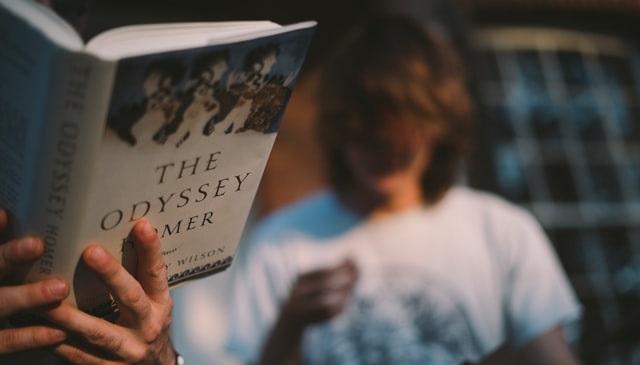
Almost since the rosy-fingered dawn of Western literature, many literary works have revolved around a journey of a hero. Throughout the journey, the protagonist typically encounters many adventures that comprise bitter enemies, romantic lovers, loyal friends, powerful forces of nature, unnatural beings, etc. However, even though some of those texts may present similar literary elements and parallels, they are yet very distinct and convey completely different meanings, values and purposes.
Two such works are the epic poem The Odyssey by Homer and the satirical novel Candide by Voltaire. This essay will discuss several similarities between the two works and the different messages they carry according to their respective genre.
The two texts’ primary means of transportation between countries and continents is by ships, in which Odysseus and Candide mostly travel in their journey to cross seas and oceans. Naturally, sailing through water holds its own unique risks and challenges that both Odysseus and Candide face throughout their quests. Interestingly enough, in the fifth chapter/book of each of the works, a similar marine adventure transpires for each of the heroes. Odysseus attempts to sail back home after Calypso allows him to leave her island, but the god Poseidon strikes down his ship with a powerful storm and wrecks it (V); equivalently, Candide travels to Lisbon with his friends Pangloss and the Anabaptist James (Jacques in other editions) when a fierce tempest smashes their ship (V).
There is a notable contrast between the causes that lead to the vessels’ wreckage – the first is the supernatural powers of the ancient Greek gods and the second is simply the harsh realistic forces of nature – this dissimilarity aid in characterizing both heroes, but in a very different fashion. Odysseus is saved by the goddesses Ino and Athena, who help him reach safety in the land of the Phaeacians; on the other hand, Candide helplessly watches his friend the Anabaptist fall into the water and drown, and when he and Pangloss finally make it to Lisbon, a deadly earthquake suddenly hits the city.
Hence, while Odysseus is perceived as a hero who manages to overcome severe hurdles across the sea and is supported by almighty gods, Candide is perceived as a hapless protagonist haunted by all sorts of natural woes anywhere he reaches. These comparable events emphasize fundamental notions of the heroes in each particular text: one hero is a glorified warrior admired even by gods, while the other hero is just an unfortunate fellow who somehow keeps on finding himself entangled in calamity after calamity.
Accordingly, the characteristics of the two heroes are quite contradictory – while Odysseus is characterized as a cunning seasoned warrior, Candide is mostly characterized as a desperately optimistic and naïve young man. However, they both demonstrate resembling cruelty at certain events during their journey. During the slaughter of the suitors by Odysseus and his son, the priest Leiodes begs Odysseus for mercy; in response, Odysseus strikes “Leiodes on the back of his neck, so that his head fell rolling” (XXII). Afterward, Odysseus orders Telemachus to kill the twelve female servants whom Odysseus deems not loyal to him during his long absence. Those brutal acts of Odysseus are intended to epitomize the heavy price of betrayal and to fully satiate the sense of vengeance as befitting in those olden times, however cruel these acts may be seen nowadays.
Contrarily, when Candide acts cruelly, his actions seem somewhat purposeless. Although the killing of the Jew by Candide can be explained as a justified act of self-defense, his subsequent killing of the Inquisitor already seems like a cold-hearted murder (IX). Candide does not even attempt to explain the morality behind this bloodshed but just says to Cunegonde, “when one is a lover, jealous and whipped by the Inquisition, one stops at nothing.” In an additional blunter episode of murderous immorality by Candide, he kills (or at least he thinks he kills) Cunegonde’s own brother during a tantrum he has (XV). Again, there is no real justification and no actual reasoning for it. For Odysseus, there is at least some sort of rationality behind his cruel killings and could be better understood in the context of that ancient era, while in Candide, the literary intention behind the killings is to mock the easiness of fatal cruelty in a hyperbolic manner.
Throughout their long and arduous journey, both Odysseus and Candide find safe harbors in which they rest and relish the local resources; intriguingly, in both texts, it occurs somewhere in the middle of the literary work. After Odysseus outsmarts the goddess Circe (X), he and his men stay in her household “for a whole twelvemonth feasting upon an untold quantity both of meat and wine.” Ultimately, in spite of the comfortable conditions on the Aeaean island, Odysseus decides to continue with his journey due to his desire for himself and his crew to return home.
Similarly, Candide and his valet Cacambo arrive at a rich and flourishing country, El Dorado, and repose there for a month before they decide to leave (XVII-XVIII). Unlike Odysseus, however, Candide’s decision to leave is not derived from pure longing for his home and loved ones but encompasses some aspects of greed. Candide explains to Cacambo that “only with twelve sheep laden with the pebbles of El Dorado, we shall be richer than all the kings in Europe,” whereas the objective of freeing his beloved Cunegonde seems only secondary. Odysseus forsakes his materialistic appetite just to pursue his wish for inner peace back home, while homeless Candide forsakes some heavenly peace in exchange for mostly materialistic yearning. Odysseus and Candide depart from alluring places of leisure and abundance alike; nonetheless, their different reasons to go along with their respective journey characterize them quite contrastingly.
Both Odysseus and Candide meet in their journey supporting characters who share analogous attributes. For Odysseus, it is the old swineherd Eumaeus who hosts and feeds him when he lands alone in Ithaca; and for Candide, it is Cunegonde’s old woman servant who protectively lodges him in Cunegonde’s abode and reconnects the couple again.
There are also some symmetries in the life story of the two aged characters – both were born to noble families but fell to the very bottom of the social class. Eumaeus was the young prince of an island called Syra, who was kidnapped and sold to slavery (XV); the old woman is the daughter of Pope Urban X, who was captured as a child by pirates and was sold to slavery as well (XI-XII). Despite those equivalences, additional events in the life of the old woman make her story far more tragic than Eumaeus’, on the verge of grotesque: her betrothed prince was murdered, she was raped multiple times, she was whipped, her mother and servants were killed in front of her eyes, and half of her butt was eaten. In contrast, Eumaeus was sold to Odysseus’ father, Laertes, and had a pretty fair life as a servant thereafter. Paradoxically, Eumaeus is constantly pessimistic about Odysseus’ fate, and the old woman ironically remains somewhat positive in spite of everything she went through as she admits, “[a] hundred times I was upon the point of killing myself; but still I loved life” (XII).
Those two supporting characters who accompany the two protagonists in parts of their journey convey two messages – Eumaeus is set as an example of loyalty and goodness, while the old woman servant underlines through her story the evil atrocities in the world and taunts the notion of hanging on to life so desperately. The old woman’s greater optimism than Eumaeus’ also stresses their different roles: she symbolizes the tenacious human attachment to life, and he is assigned to aggrandize the unbelievable return of Odysseus after his heroic journey.
As demonstrated by the above aspects from The Odyssey and Candide, there are corresponding parallels in these literary texts that are incorporated into the heroes’ journeys. However, the aspects in each text are fraught with distinctively individual messages. For Odysseus, they primarily glorify the hero and his courageous endurance; for Candide, they present an exaggerated reflection of the grim reality up to the absurd.
Both journeys end when the heroes are safe, but even then, the differences are prominent – Odysseus makes peace with those who seek to avenge the death of the suitors (XXIV), which indicates the completion of his journey. Candide, however, just prefers to work in the serene garden rather than deal with the sufferings of the outside world (XXX), which suggests that his journey does not end in total happiness. Unfortunately, the journey of this essay ends as well, hopefully in a complete sense of joy and peace.



